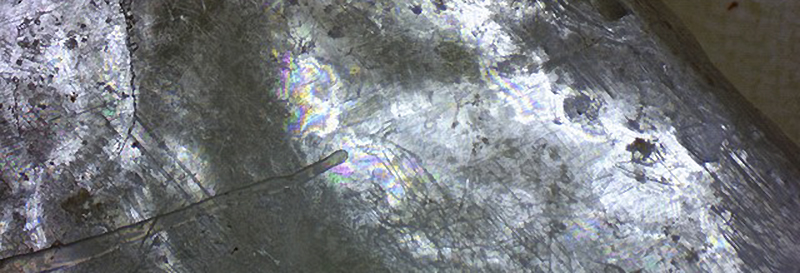Specularia
The term specularia, is often used to describe a small genus of annual herbs, however it can also be used in reference to the Latin meaning of letting light in or transparency. Lapis specularis is also used to describe the selenite crystal form of gypsum (selenitic) that forms in thin sheets. Specularis might be used to describe to a mirroring quality. Other references refer to specularium as the Latin nominative case to mean a window-pane, transparency, or a piece of glass letting through light into a building (specularum, also has historical references to a watchtower or light house).
Specularia appears in two surviving Roman texts: Historia Naturalis, referenced by the Roman agricultural savant Pliny the Elder who describes “beds mounted on wheels which they moved out into the sun and then on wintry days withdrew under the cover of frames, glazed with transparent stone or mica to provide fruits of cucumis.” The second De Re Rustica (On Agriculture) by Columella goes further recommending siting near buildings for wind protection and warmth for the beds.
Many years later in the 1500's the purpose of these devices was described; “The young plants may be defended from cold and boisterous windes, yea, frosts, the cold aire, and hot Sunne, if Glasses made for the onely purpose, be set over them, which on such wise bestowed on the beds, yeelded in a manner to Tiberius Caesar, Cucumbers all the year, in which he took great delight...” (Thomas Hill, “The Gardener’s Labyrinth”, 1577).
In 2010 in the paper; What the Roman emperor Tiberius grew in his greenhouse and in 2022 article History of Controlled Environment Horticulture: Ancient Origins both by H.S. Paris and J. Janick, it is argued that it was actually melons (Cucumis melo) that were grown, ones that lacked sweetness, rather than cucumbers (Cucumis sativus) as described by Hill, describing more specifically the details and other varieties of plants grown in these early greenhouses.
In any case the purpose of these greenhouses was to prolong the growing season for the crop which according to Pliny “a delicacy for which the Emperor Tiberius (reigning from 42 BCE-37 CE), had a remarkable partiality; in fact there was never a day on which he was not supplied it.” Other references talk of specularium and specularia as buildings or early green houses made on the same principles, just static, though this is not clear in history, even if the material was.
The material used is sometimes described as being mica, which is any of the group of hydrous aluminosilicate minerals which form in layers, more specifically it is likely to have been Lapis Specularis the form of Selenite or naturally pure crystalline gypsum. Selenite crystals form in large flat, transparent crystals, often called plates or windows and although at this time the Romans were able to produce glass it was not developed enough for panes as such and only used for small jewellery items and beads. It was around 100AD that Romans, by then adept at glass blowing, started to blow flattened glass tubes, which were then effectively cut in half to create the first window panes.
[edit] Related articles on Designing Buildings
- Botanical gardens
- Biomes.
- Building an extension.
- Conservatory.
- Garden greenhouse.
- Hydroponics and buildings.
- Selenite.
- Satin spar.
- The secret life of the Georgian garden.
- Types of glass.
- Winter gardens.
[edit] External References
Featured articles and news
The UK's Modern Industrial Strategy: A 10 year plan
Previous consultation criticism, current key elements and general support with some persisting reservations.
Building Safety Regulator reforms
New roles, new staff and a new fast track service pave the way for a single construction regulator.
Architectural Technologist CPDs and Communications
CIAT CPD… and how you can do it!
Cooling centres and cool spaces
Managing extreme heat in cities by directing the public to places for heat stress relief and water sources.
Winter gardens: A brief history and warm variations
Extending the season with glass in different forms and terms.
Restoring Great Yarmouth's Winter Gardens
Transforming one of the least sustainable constructions imaginable.
Construction Skills Mission Board launch sector drive
Newly formed government and industry collaboration set strategy for recruiting an additional 100,000 construction workers a year.
New Architects Code comes into effect in September 2025
ARB Architects Code of Conduct and Practice available with ongoing consultation regarding guidance.
Welsh Skills Body (Medr) launches ambitious plan
The new skills body brings together funding and regulation of tertiary education and research for the devolved nation.
Paul Gandy FCIOB announced as next CIOB President
Former Tilbury Douglas CEO takes helm.
UK Infrastructure: A 10 Year Strategy. In brief with reactions
With the National Infrastructure and Service Transformation Authority (NISTA).
Ebenezer Howard: inventor of the garden city. Book review.
The Grenfell Tower fire, eight years on
A time to pause and reflect as Dubai tower block fire reported just before anniversary.
Airtightness Topic Guide BSRIA TG 27/2025
Explaining the basics of airtightness, what it is, why it's important, when it's required and how it's carried out.
Construction contract awards hit lowest point of 2025
Plummeting for second consecutive month, intensifying concerns for housing and infrastructure goals.
Understanding Mental Health in the Built Environment 2025
Examining the state of mental health in construction, shedding light on levels of stress, anxiety and depression.























Comments
[edit] To make a comment about this article, click 'Add a comment' above. Separate your comments from any existing comments by inserting a horizontal line.